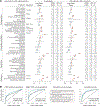Population-scale longitudinal mapping of COVID-19 symptoms, behaviour and testing
- PMID: 32848231
- PMCID: PMC7501153
- DOI: 10.1038/s41562-020-00944-2
Population-scale longitudinal mapping of COVID-19 symptoms, behaviour and testing
Abstract
Despite the widespread implementation of public health measures, coronavirus disease 2019 (COVID-19) continues to spread in the United States. To facilitate an agile response to the pandemic, we developed How We Feel, a web and mobile application that collects longitudinal self-reported survey responses on health, behaviour and demographics. Here, we report results from over 500,000 users in the United States from 2 April 2020 to 12 May 2020. We show that self-reported surveys can be used to build predictive models to identify likely COVID-19-positive individuals. We find evidence among our users for asymptomatic or presymptomatic presentation; show a variety of exposure, occupational and demographic risk factors for COVID-19 beyond symptoms; reveal factors for which users have been SARS-CoV-2 PCR tested; and highlight the temporal dynamics of symptoms and self-isolation behaviour. These results highlight the utility of collecting a diverse set of symptomatic, demographic, exposure and behavioural self-reported data to fight the COVID-19 pandemic.
Conflict of interest statement
Competing Interests:
The authors declare no competing interests.
Figures













Update of
-
Population-scale Longitudinal Mapping of COVID-19 Symptoms, Behavior, and Testing Identifies Contributors to Continued Disease Spread in the United States.medRxiv [Preprint]. 2020 Jun 11:2020.06.09.20126813. doi: 10.1101/2020.06.09.20126813. medRxiv. 2020. Update in: Nat Hum Behav. 2020 Sep;4(9):972-982. doi: 10.1038/s41562-020-00944-2. PMID: 32577674 Free PMC article. Updated. Preprint.
References
Publication types
MeSH terms
Grants and funding
LinkOut - more resources
Full Text Sources
Medical
Miscellaneous

